Ed. note— This interview of Daniel Drennan ElAwar was conducted by Nabil Chehade at American University of Beirut, where Mr. Drennan has been teaching.
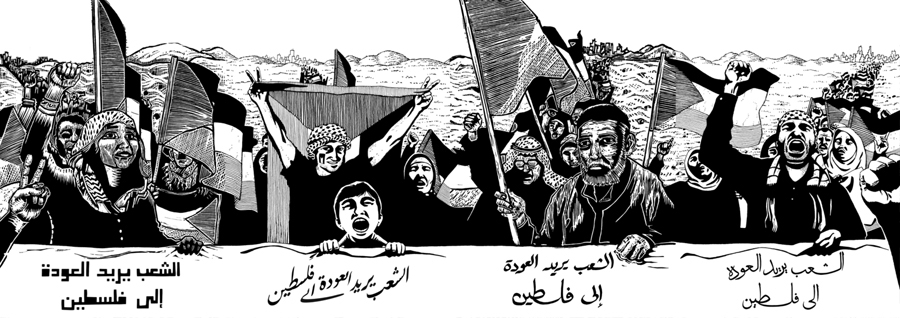
Series of four posters for the Return to Palestine March, May 15, 2011. Artist: Jamaa Al-Yad
NC: Have you been involved in any projects that lean directly towards more political issues in Lebanon and or the Arab world? If so, what are some examples?
DD: A few years ago we founded an artists’ collective, Jamaa Al-Yad. Our aim is to “empower and activate voice”; we have been working so far on a variety of projects that mostly address issues concerning Palestine, though we are starting to branch out a bit. For example, we created a variety of posters to commemorate historic events (the “nakba,” the “naksa”); the Right of Return Conference held in Beirut; Israeli Apartheid Week and BDS efforts; the Right of Return March to Palestine; etc. We’ve participated in events that engage people in terms of cultural expression and their environment, and most recently we curated an exhibition of Palestinian posters in conjunction with ESCWA for the commemoration of the International Day of Solidarity With Palestine held at UNESCO Palace in Beirut. So we see ourselves in a bigger picture than just creating political artworks.
NC: Did they leave any impact or promote change effectively?
DD: The question I think is slightly problematic, because it is asking for a quantifiable answer to a qualitative action. Sometimes I wonder if this is a function of our design education–based in a corporate/business/advertising mentality as it is, and not of activism necessarily. Because history shows us that change in society often comes years if not decades after what were often considered to be “failed” activist actions. For example, the peace demonstrations concerning World War I in the United States, led mostly by socialist and anarchist activists such as Emma Goldman, did not prevent the United States from going to war in Europe; they did result in Emma Goldman’s deportation, and the co-optation of the women’s suffrage movement into supporting the war effort. But the energies from this manifested themselves later in the activism of the Depression era and beyond.

Over-mediated candlelight vigil held downtown at Martyr’s Square, Beirut during the Summer War of 2006. Credit: As-Safir newspaper
When I was speaking about our group’s work two summers ago at the Socialism Conference in Oakland, California, I found myself talking with a former member of the Black Panther Party. I asked him how he persevered after watching his comrades either assassinated, imprisoned, or exiled. He replied that the way he looks at it, he might not see change in his lifetime, but he will have passed the torch. It’s a different way of looking at things. This is similar to what we hear from various local activists when they say that “existence is resistance”; we have to meld our life with our activism, it can’t be something separate, an “awareness campaign” that we just up and do, and then we return to our day-to-day. So I do not look for immediate effect, but instead see how people engage with the work, react to it, and build from it. We critique our own efforts, learn from our mistakes, and build from there as well. And so there are many ways of judging success in terms of our work. Are we successful because our posters were published as a newspaper supplement? Is it the number of people who have seen our work on billboards, posters, on television, online? Or is it that our work is seen in galleries or museums, or at conferences? Whose positive reaction means most to us? Once, while we were working on our Israeli Apartheid Week collection of posters, a member asked me: “What if no one puts the posters up?“ Basically, “What’s the point?“ I replied that if just one Palestinian child put up one poster and found it inspiring, even if the rest got trashed this would be enough for me; it would have been worth the effort. Similarly a child stenciling the Corniche, if she realizes that she can make a valid mark, a statement, that she has a voice, this is worth more than anything.
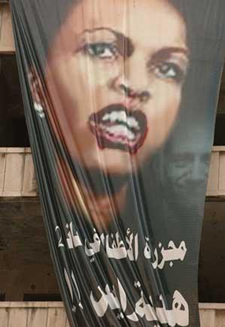
Banner hung in downtown Beirut during the 2006 Summer War. Artist: Unknown
NC: Did this encourage others to develop an interest in such topics or causes? DD: I think we are seeing a huge sea change in what you are calling here “interest” in such topics or causes. By this I mean to say that I don’t think people necessarily develop an interest in a given topic, but instead it is awakened, and they are activated. This is the problematic inherent in most “awareness” campaigns. People are aware; they don’t need to be preached to; there are a million reasons why people are disincentivized to act. When we were working on the newspaper for Israeli Apartheid Week, for example, our members started recounting how their parents finally opened up about their own activism during the civil war, and their wheat-pasting of posters on the city walls; we activated two generations at the same time. So it is to me less about convincing people and more about engaging them and activating them with what they already know are causes based in social justice. It is about tipping the scale in favor of the activism that lies latent within all of us, given the proper incentives.
NC: How do you view people’s enthusiasm for creating illustrative graphics for left-leaning causes today in Lebanon? I would think this has changed or calmed down over the last couple of years in Lebanon from the situation around 2001-2007, during the inner turmoil with political issues, and the effect of Bush, Iraq, and Sept. 11, 2001. How has it changed?
DD: Lebanon is a very particular case; we have to examine it in terms of its political and economic history. There is no history to this country other than one framed along neo-liberal economic lines; meaning, the governmental, legal, educational, social, and cultural systems existing here work within an economic model that has always been purely capitalistic and serving comprador and foreign interests. Period. Unlike our neighbors going through various revolutions, there has never been an official government or “regime” here that advocated for, say, socialism, or Pan-Arabism, or a break with foreign interests. So the left-leaning causes end up being centered elsewhere, and they resonate back here, especially in terms of specific industries, like publishing. But when they actually managed to gain strength and popular support, they became targeted. The destruction of the left-wing coalition that went up against the local system and acted in a resistant capacity wholly outside of this mode gave us the civil war. This has not been recovered from yet.
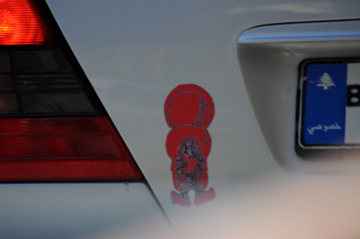
Bumper sticker of “Handala”, the creation of Palestinian caricaturist Naji Al-Ali; May 2011.
Just like in the United States and most of the First World, Capital has co-opted the left and progressive elements if not eliminated them; on the flip side we have an imposition of a mindset that has segments of the population claiming to be “progressive” but who do not want to give up their bourgeois privilege as guarded and protected by this entrenched system. So in terms of creative output there might currently be a bit of barking, but it is safe and within limits; there is certainly no bite, especially of the hand that feeds them. And what you notice is that the expression is well within the parameters set by these economic systems: In foreign languages, aimed at foreign media/NGO audiences, or placed online or in particular media outside of the reach of the street. During the election campaigns and after the war in 2006 you notice a shift to the advertising realm away from what was formerly expressed on the street. So it’s not so much a calming down, but an effective “defanging” of popular expression.
NC: In terms of local illustration, we have had editorial strips, civil war/political posters, and recently more subversive or online local comics that used illustration as means to go against something or somebody, and to satire, support, or propagandize political issues. Do you feel that there is a large gap between the situation here in comparison with that in modern non-western countries, Arab or otherwise, who have developed more of a base? If so, in what way?
DD: The gap is certainly not between what we might wrongly refer to as “East” and “West”. There has always been an active graphic tradition, but it has settled into a more or less sectarian mode, where graphic production is for a local party that oversees a given neighborhood or community as opposed to a given grander ideal. This insularity is not necessarily a fault of individuals, but a desired and incentivized fragmentation from above of political actors on the local stage. I would differentiate though between what was traditionally and historically produced in terms of posters, coupled with printers and other disseminators and communicators who were all of a decidedly populist nature, and what is found in the online realm today, along with the English- and French-language publications that are, on the contrary, elitist in nature and in content.
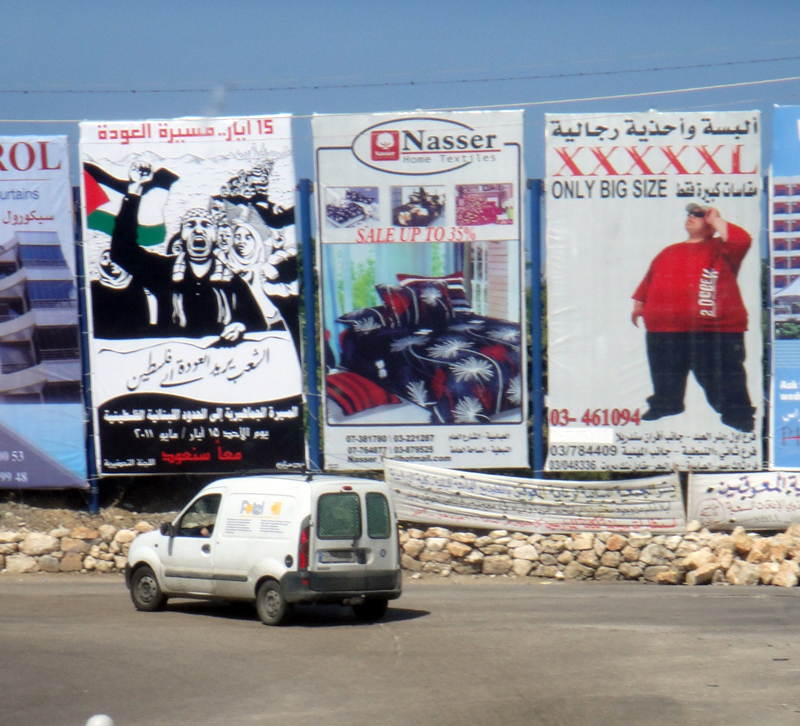
Banner for the Return to Palestine March, May, 2011. To note is that the original image has been colorized and has additional information added. Artist: Jamaa Al-Yad and unknown
To be considered here are aspects of a framework that we use in our collective to analyze any manifestation along these lines. Namely, the artist involved, what is her ability and right to speak? What is her luxury or privilege beyond that to say what she wishes? Finally, what audience is she speaking to, in what medium, via what venue, at what cost? If I am of a class removed from the street, and I am publishing cartoon strips in an online realm removed from the majority of the population’s ability to access them, in a language foreign to them beyond that, who am I serving? If I bring Emory Douglas into the Beirut Art Center and charge fifty dollars to participate in a workshop with him, who am I serving except my own class vanity? This isn’t subversive; this is playing “edgy” with one’s class status, this is slumming it. This is a completely different from publishing subversive work or expressing oneself subversively. I would also be careful of using the word “modern.” Things aren’t “backwards” here; they are in fact refreshingly active if one can step down from one’s class position enough to notice. The so-called First World is the one which has gone stagnant, now that it has exported its local printers’ trade and craft, co-opted and destroyed any concept of local media, and has replaced true activism with a disturbing post-modern version that would have us accept our condition as a given, with minor divergences from this somehow labeled “resistant”. This shift in focus is a function of Capital, where dissent is allowed within the parameters of the system itself. It should be seen for what it is, and resisted at all costs.
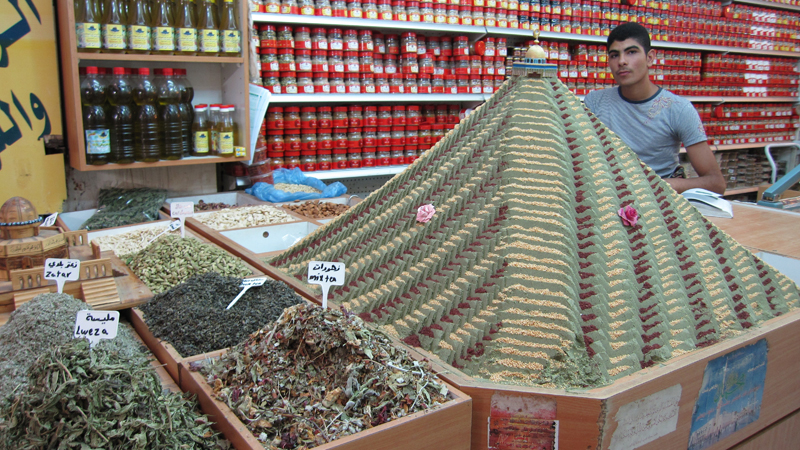
Grocery store, Ramallah, featuring a tower of zaatar spice mix with the Dome of the Rock posed on top. On the side of the bin are posted similar political messages in poster form. Artist: unknown. Photographer: Stephen Sheehi
NC: Is there a missing training that the new generation of such cases in Lebanon who, not to generalize, tend to jump from some amateur artistic and Adobe Illustrator skills without undergoing all the training, methods, and skills that the previous generations had?
DD: What is missing first and foremost is life experience. I can’t relate what I don’t know. I was an illustration major at one time, and I remember my naïve attempts at expressing myself along these lines— I don’t think this invalidated this expression, however. But I knew my role, and I knew what was missing: I devoured every book, every magazine, every bit of information I could find; I was looking for a way of grounding my work. Much of the work we see today is woefully ungrounded; there is no framework to it, it speaks solipsistically as if this is in and of itself valid. Some of the strongest statements of an activist nature you will find have traditionally been done by those we would not consider “trained,” so this is perhaps not the way to look at things. The problem is more with young people speaking of issues while not having a firm grasp of their history and context. But this is not unique to Lebanon, in any case. The imposition of university training in graphic design on what was formerly learned on the job, as an apprentice (to a printer, for example), or by one’s owns wits, has changed how we look at such work and not in a good way; it is now in an elitist way that runs counter to an activist mindset. The modern university is a corporate entity with corporate interests. What can we expect it to teach/produce?
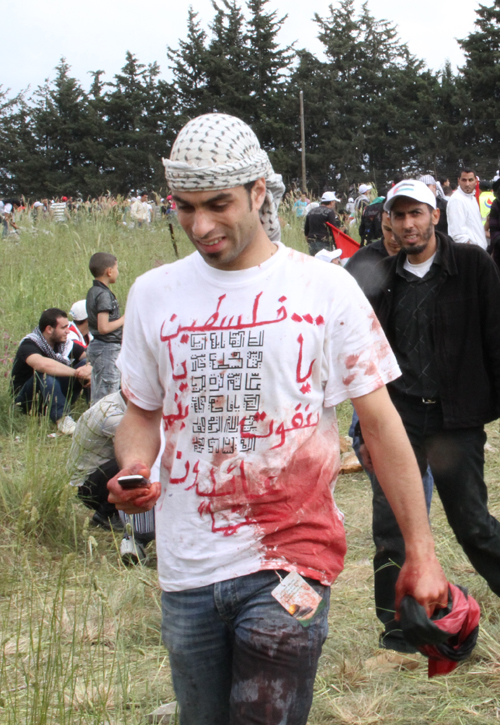
From the Return to Palestine March, May 15, 2011. The T-shirt lists in square kufi calligraphy the names of various Palestinian towns; to this the wearer has added the message: “Palestine: We enter or we die. . .we will be back.” Artist: unknown. Photographer: unknown
The academic design realm separates “designer” work from cultural manifestations that are just as much of merit, or it tries to re-categorize former historical works as “graphic design,” which is wrongful in approach as well as being a tautological deceit. We need to give credit where credit is due, period. Most of the “big-name” designers/illustrators I’ve worked for in my lifetime have never had one minute of university design training; they are the first to recognize that “design” as we know it in terms of its underlying crafts and trades has very proletarian and commercial roots. But you bring up an interesting issue when you mention computer skills. There is something to be said about techniques that have been traditionally used by revolutionary artists— for example, printmaking— and what they represent on this purely technical level. What they reflect is communal and collaborative work, coming out of a “taller” or a studio, requiring a variety of skills from various contributors. In this way the creation of the work reflects the political outlook of the creators: They think collectively and act/work collectively as well.
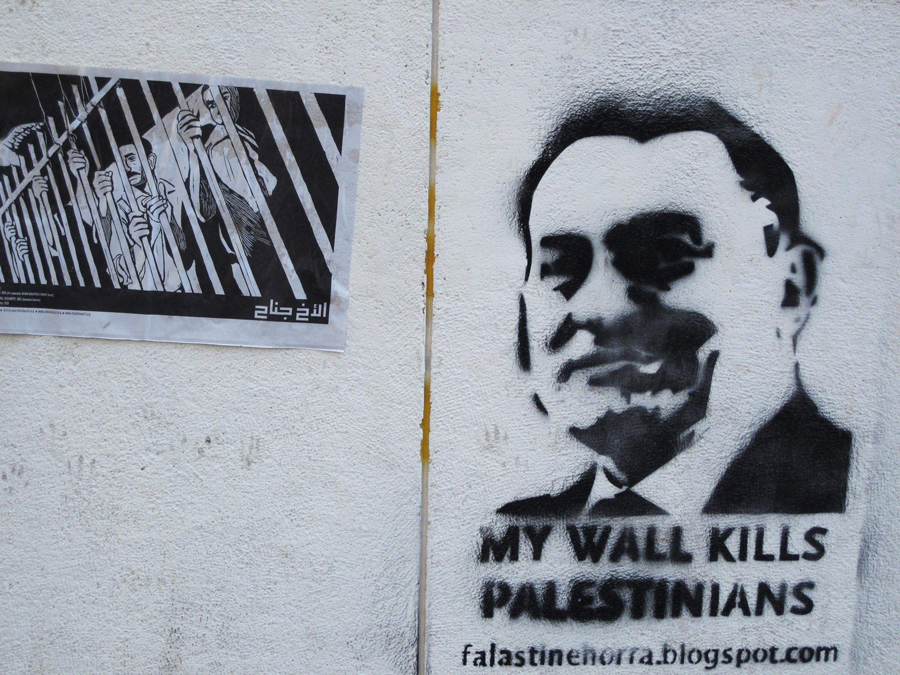
Stencil graffiti from Hamra, Beirut. Artist: Falastine Horra
This is radically different from the lone individual on his computer, reflecting a different sensibility. But even in some “collectives” we can see the individualistic mindset at work, as incentivized by Capital. In discussing our collectives, a friend from New York and I were comparing notes. He was amazed that we didn’t give individual credits to our prints concerning who authored them. He told me that were he to apply this in his collective, half the artists would walk away. We see this in our education as well. Group work by those who accept the group as a given is one thing; group work done by individuals who accept the group as a temporary inconvenience is another. How many graphic design students “hate” group work? How many students will have no problem trashing another student’s work long before they think of helping that student? I saw this the other day; students outside the department trashing a poster of their friend and classmate. How many of them saw that student working and didn’t think to help or contribute something? The easiest thing in the world is to criticize. This is a fundamental mode that again ties back to Lebanon’s history and educational system.
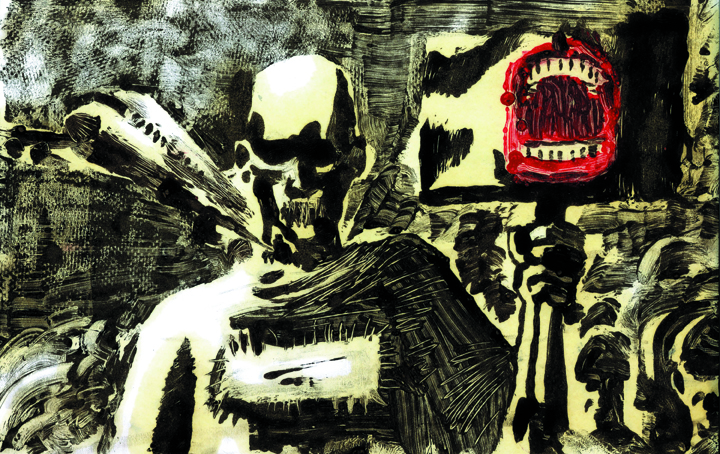
Student work, illustrating an article entitled, “We Will Not Be Silent,” relating the story of an Arab man prevented from boarding an airplane for the above statement written on his T-shirt. Artist: Fouad Mezher (monoprint)
I would also blame current trends in “conceptual” design, as well as a workplace that demands software skills above actual creative thinking. Given a solid year of work in a printer’s shop, setting type by hand, binding books, working with ink, a student will walk away with much more in the way of education than what we see currently in graphic design education. But this is where I also blame the student, who should be drawing every day, writing every day, reading every day; spending hours in the library, reading every newspaper, every magazine, consuming knowledge. A student who doesn’t do this is just a robot in an echo chamber.
NC: Do you think this is reflected in new political illustrations or treatments, as opposed to the more traditional techniques found on the civil war posters?
DD: I would go back now and say that there is a certain level of “astutelessness” in much of the work I currently see among those of a certain societal class. I think this is because of a lack of knowledge of techniques that are seen as purely technical, or else “working class;” i.e., silkscreen, printmaking, etc. People of this class want to be immediately considered “artists” without putting in the time, or else they desire to follow in the caricature tradition. What ends up being produced is a doodling mess with no impact. Our great caricaturists have refined their concepts based on a lifetime of experience. They are also learned and well-read in the local culture; this is missing here. I have no problem looking at art that is “young” in terms of maturity but which has a valid message and framework underpinning it. Eventually the technique will catch up.

Poster for a march through Hamra, Beirut. Over-mediated like the candlelight vigil, reflecting info-graphics and a statistical representation of the War on Gaza. Artist: unknown
NC: There are artists such as Jad Khoury who produced some comics during the mid 1980s which were banned due to having messages against certain laws and policies of the day. What do you make of the double standards of the way things are restricted? Do you have any examples where your works or other peoples’ works have been banned, stopped, or restricted for certain reasons?
DD: My examples of work that was banned, stopped, or restricted came mostly during my work as a designer and art director in the corporate realm, as well as publishing my own magazine in the early 1990s. In this capacity, I have received cease-and-desist letters from the Disney Corporation, the Spelling Entertainment Company; I have worked with editors who have not allowed illustrative work to go through for personal or political reasons. So the corporate domain that is the driving force for design as we know it today is also as restrictive as many governments.
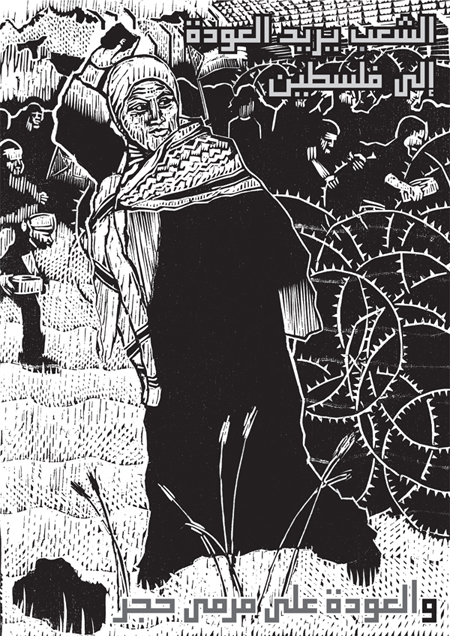
Poster commemorating the martyrs of the Return to Palestine March, May 15, 2011. Poster reads: “Return is but a stone’s throw away”. Artist: Jamaa Al-Yad
I bring this up to say that we should analyze here the various ways in which censorship works. Earlier I mentioned “rights;” so for example I might not have the expressly legal right to air a certain view. In other cases, I might have the right to express myself, but not in a given way; for example, anti-graffiti laws come in to play here. I might have the right, say, within copyright law— this was the case with Disney, above— but I also know that they will drag me into court and I will pay a lot of money to end up justified; it ends up not being worth it. Furthermore, I might have the luxury to make a particular statement because I am of means, or have wasta, or otherwise can circumvent the laws that others have to abide by. Within this though I might not have the privilege to express myself, meaning, I might bow to local, communal, religious, or personal convictions. What I mean is that Lebanon is not alone here; the Sedition Act of the United States was passed within seven years of the so-called American Revolution. Various levels and degrees of laws banning treason and sedition have been established since then, in an escalating crackdown on “freedom of expression,” an expression that we might now see as never having actually been free to begin with. Lebanon is much freer in this regard, simply because there are limits set mostly by profit-making, with further constrictions more on the privilege level, as described above. So we need to be very careful of how we frame this. In any case, who is capable of/able to protest and who is actually punished for it are two completely different things.
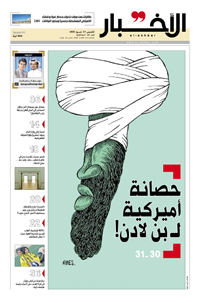
Caricature illustrating a front-page story on Al-Qaeda and Osama Bin-Laden in Al-Akhbar newspaper. Artist: Ares/Cuba
And so we should look at systemic censorship as well. For example, certain Lebanese bloggers were up in arms recently because the government was thinking of requiring them to register officially, and this was seen as a censorship of their voice. But I would argue that lack of access to the Internet does more to censor more people than this government intervention; that it is hard to call the above “censorship” when it represents just one percent of the potential voice of the populace, a group of people who, for financial reasons among others, cannot get themselves heard in a similar way. So how do these systems work? Governmental, but also academic, institutional, and market-based systems— how do they give Voice to some, and take away Voice from others? What are you able to learn/read/study in university, and what never comes your way? Who is able to teach, and who is removed? Who comes to lecture, and who is overlooked? These aren’t innocent decisions. This is much bigger and much more insidious and perfidious than the quite obvious buffoonish local attempts of the government to formalize the informal economies under its purview.
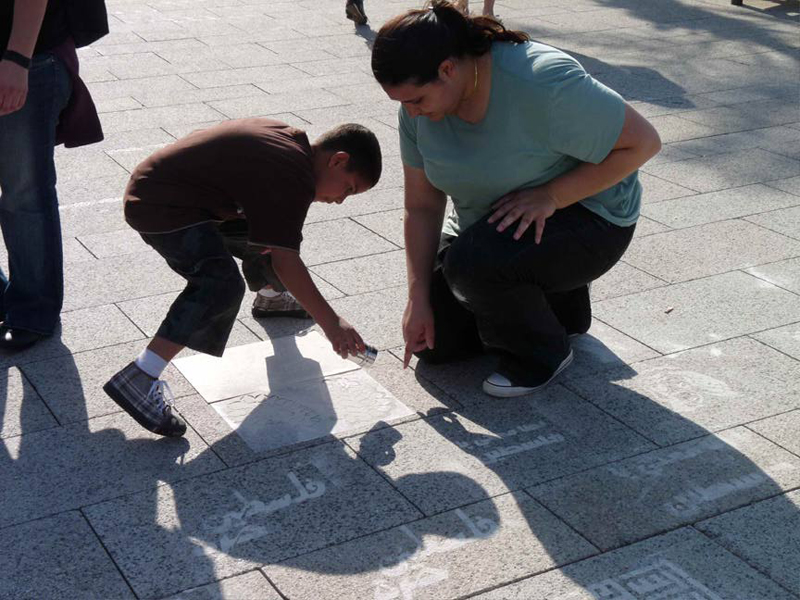
Intervention on Corniche, Beirut, using calligraphic/image stencils and powdered gypsum for Free Palestine Festival. Artist: Jamaa Al-Yad
NC: Do you think there is an increasing number of people who have progressively become more secular in regards to visually tackling political issues?
DD: I think there is a collective “safety zone” that disallows overt religious references, or else allows their combination in a very clichéd way; crosses and crescents together, for example. I don’t know that there is a “secular” way to tackle political issues, especially given the fact that those who have the luxury to claim a “secular” place in society are not necessarily the most progressive in terms of class equality or the like. By this I mean to say that “secular” doesn’t necessarily equate to a good thing in terms of politics. Some of the most progressive politics comes from various liberation theologies for example; there are many scholars who study religion as it ties in to Marxist or other liberationist isms. In this crossover is much more creative potential than in what we might label as purely secular.
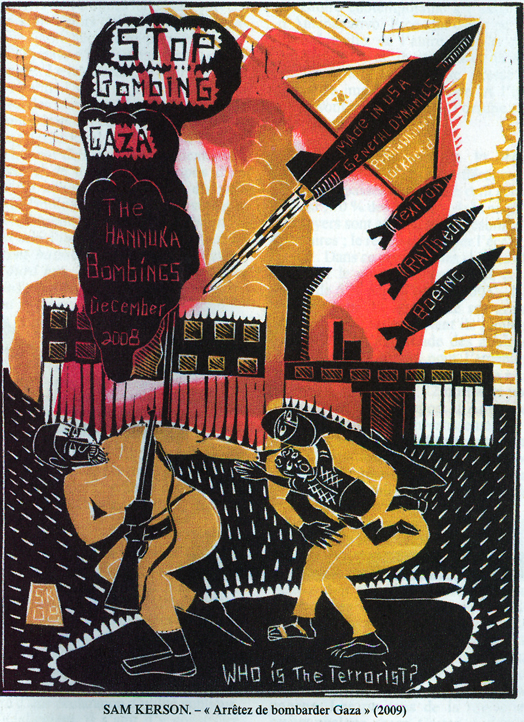
Illustration from Le Monde Diplomatique, revealing the economic incentives to the War on Gaza as well as requestioning the label of terrorist. Artist: Sam Kerson
Locally there is a pernicious colonialist mentality that would have the so-called Enlightened, secular, civilized, modern “West” as being the model to follow to tackle political issues, usually by adopting a false “objective” stance. But this is bogus on more than one level, first because these so-called secular countries all have official national churches, if not monarchies or pseudo-monarchies. Second because it posits a false equality in the discussion that must take place from within the systemic parameters of Capital. I notice this most in false debates that take place, some recently here on campus, where discussion of the issue at hand is replaced by a focus on the “how” as soon as the “underdog” starts to make headway in the discussion. At that point, “how” people express themselves comes under attack. This is another systemic way that those in power maintain those dominated in check; this is parliamentary procedure, this is Robert’s Rules of Order, this is the debate team format. I much prefer people yelling at each other, and eventually settling into a discussion. Intellectually, it’s more honest.
NC: During the civil war and continuing till today, there have been illustrations that propagandize political parties and conservative religious ethics even in children’s magazines. Do you think these still have negative impact as they once did?
DD: Extending what I was saying in reply to the last question, I am careful not to call what you are referring to as propaganda, especially if we are not going to also point out as propaganda, say, showing “Schindler’s List” in the history classes of the International College, or analyzing the coloring books in other local American schools that would have their students trying to convince teta to remove her veil in the name of “modernizing” herself.
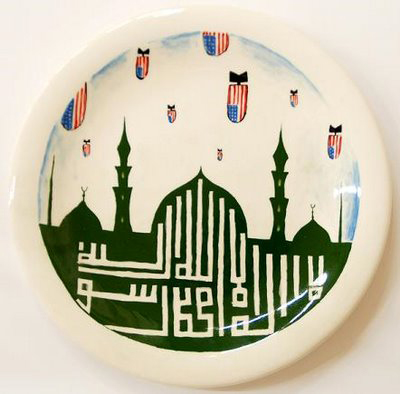
Plate illustrated with the Islamic proclamation of faith and American bombs raining down. Artist: Unknown
What is the lived context of the population? How do they see themselves? Describe themselves? How does this reflect notions of class, and past marginalization? This is often in direct contrast to more official doctrines from these people’s sects or political parties, and again, such “propaganda” is often vociferously disagreed with on this level. By this I mean to say that we allow ourselves the benefit of the doubt and the ability to disagree with what we consider to be propaganda but we don’t extend this to the average person on the street; we allow ourselves an individuated freedom, and then see others as homogenous blocks. This is a classist conceit. We have to start with on-the-ground and on-the-street reality, in all of its complexity. Frankly, I much prefer the overtly political or religious statement which is still argued or debated internally, i.e., allows for a dialectic, as opposed to the imposed “message” from more insidious sources outside of the communities and the streets of Lebanon. Let me ask it this way: Which is worse, the obviously religious iconography or calligraphy that speaks to a subset of the population, but which might still be incredibly powerful and aesthetically beautiful? Or else the packaged and contrived “Cedar Revolution,” sponsored by USAID and Saatchi and Saatchi in 2005? Who would you rather claim as an example of activism, the Yemeni woman on the streets of her city clad in a chador clutching a portrait of Che Guevara, or else the Lebanese illustrator exhibited in a private gallery in Brazil, and whose work portrays scantily clad women dancing on a bar in Gemmayzeh as somehow representative of lived reality in Beirut? Who is truly more progressive here? I will accept the label of propaganda only when we also apply it to the visiting lecturer at AUB from the World Bank, or Solidère, or USAID, to the Disney Channel on Lebanese satellite TV, to the entire curriculum of IC and ACS, AUB, etc.
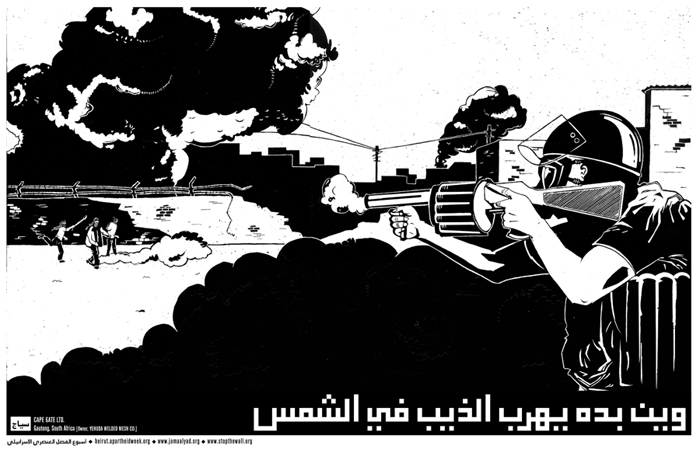
Poster for Israeli Apartheid Week, Beirut, published as a newspaper supplement to Al-Akhbar newspaper with instructions on making wheat paste and putting posters on walls. Artist: Jamaa Al Yad
NC: Do you feel there is a large gap between traditional caricaturists and newly emerging illustrators who deal with political issues?
DD: Some emerging illustrators are woefully removed from reality, in terms of their elite education, their freedom from having to work, and their lack of life experience. Others have managed to overcome this by sinking themselves in a truly local and communal context, and are producing amazing work. I think the caricaturists and their style overwhelm us because the other historically relevant techniques have fallen into disuse over time and with the advent of the computer. Perhaps it is time for a renaissance of this kind of work.
NC: Who are some individuals who effectively are successful in creating political illustrations in Lebanon? Is there an ever-growing number of people? Or have they always existed and mainly stayed in the realm of caricature/editorial strips?
DD: I don’t know how to define “successful” here. I think of artists such as Burhan Karkoutly and caricaturists that are well known for their messages such as Naji Al-Ali, but I just as much think of murals in the Palestinian camps and political artwork in our various neighborhoods which are more or less anonymous to us for us not being local to those manifestations. I actually think we need less of the “known” artists, and more of the Marxist idea as proposed by Ernst Fischer and many others that everyone is capable of cultural or artistic expression. Having said that, some of the contemporary younger regional artists whose work I appreciate include Nidal El-Khairy and Amal Kaawash from Palestine, especially in their awareness of popular cultural form as well as the difference between activism and passivism. Mohamed Gaber from Egypt is fully grounded in terms of framework, and this manifests itself clearly in his work. Bridging out to artists who are not local but who connect their own struggles to those of this region, I would point out Jesus Barraza and Melanie Cervantes as well as Juan Fuentes who have tackled the issue of Palestine as well as local revolutions. Hugely inspirational as well in this regard is Josh MacPhee and the Just Seeds Collective. Just to name a few.
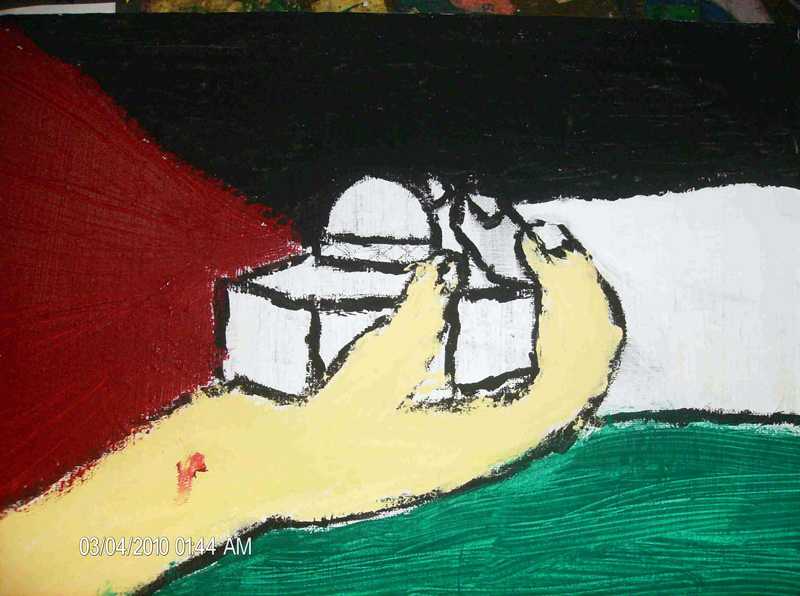
Painting from the Bourj Al-Barajneh Palestinian camp, Beirut, featuring the flag and the Dome of the Rock. Artist: Unknown
NC: Do you think Lebanon has a lot of room for possible potential in regards to socially aware left-leaning/neutral based political illustration?
DD: Everywhere on earth has such potential. Unfortunately, Lebanon has one class of people with the privilege to speak out on these issues but without the will or desire to truly do so; while another class of people exists with the desire to scream out loud but which lacks the means and the privilege to do so. For example, we recently saw a demonstration downtown in support of the “Syrian people;” the organizers defined themselves as “artists, writers, intellectuals.” This automatically left out the huge population of Syrian workers in their midst; why this class distinction? Furthermore, these workers are not without Voice; go to Idlib, to Homs, talk with the workers from these regions, listen to their chants, look at their drawings and calligraphed banners; is this not valid creative expression? Do we honestly think they would hold a candlelight vigil for themselves or their martyrs? They don’t have the luxury to mourn in this super-mediated way; but a martyr’s portrait, on the other hand, that feeds back into the revolution becomes valid along these lines. Their chants name their martyrs in a celebration of Voice; this is very powerful especially compared to the spiritually dead information graphics and statistical reference often made in their stead from a mediated remove, as seen in the poster for a Hamra demonstration concerning the War on Gaza, which likewise was held separately from the street demonstrations at the various embassies in Beirut. We need to close this class divide.
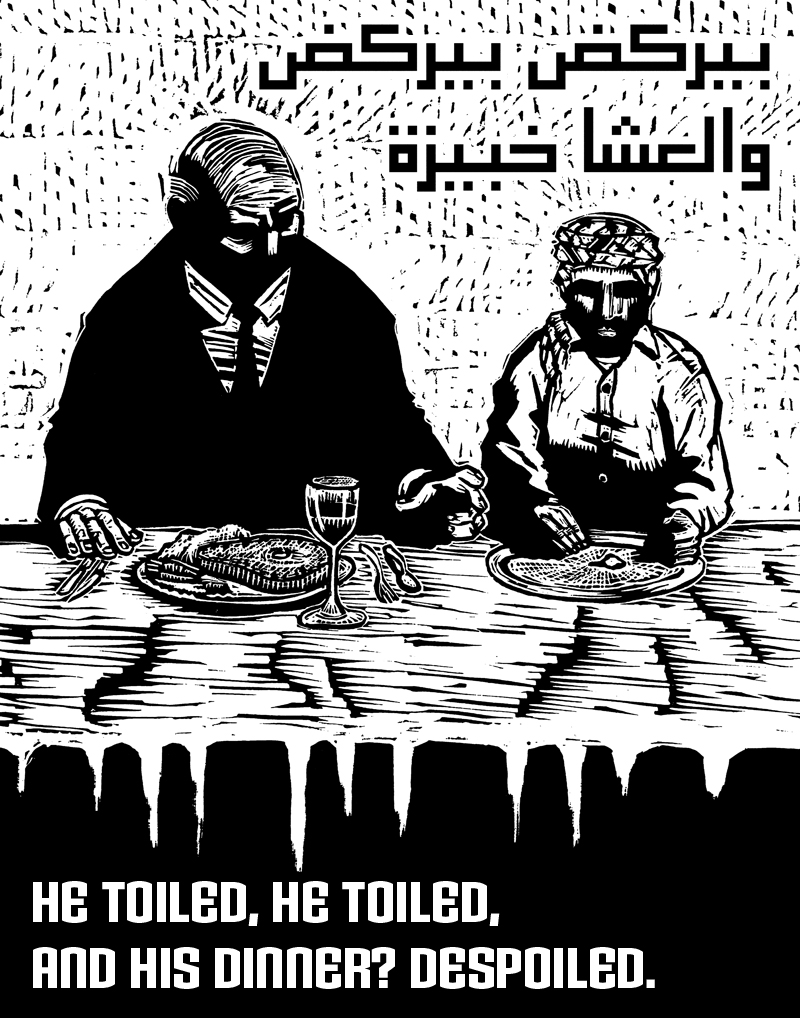
Poster for the Occupied Wall Street Journal. The request was for a poster that would tie into the “Occupy” movement but reflect a local take in terms of subject matter. Artist: Jamaa Al-Yad
With all of this local upheaval, we’ll see who ends up speaking out, and speaking loudest. In any case, I would say that “Lebanon” as an entity becomes a false marker; a local artist who claims to be “Lebanese” has already failed the “progressive/leftist” test, if you ask me. More importantly, activists are bridging movements and crossing borders. For example, The “Occupied Wall Street Journal” asked us to produce a poster for their newspaper; they specifically wanted a poster that reflected our local reality but that would work with their “global” notion of occupying various locations around the world in the name of the “99%” of the population marginalized by current economic and political realities. The list of countries that I can see from our web logs downloading this poster worldwide is truly inspiring and gives me hope that artwork produced within a proper framework can indeed help to change our lived condition.
Nabil Chehade is a third-year student in the Graphic Design program at the American University of Beirut; this interview was for a magazine project in his publication design studio. Daniel Drennan is the founder of Jamaa Al Yad artists’ collective located in Beirut. Mr. Drennan can be reached at daniel.drennan@jamaalyad.org











Leave a Reply
You must be logged in to post a comment.